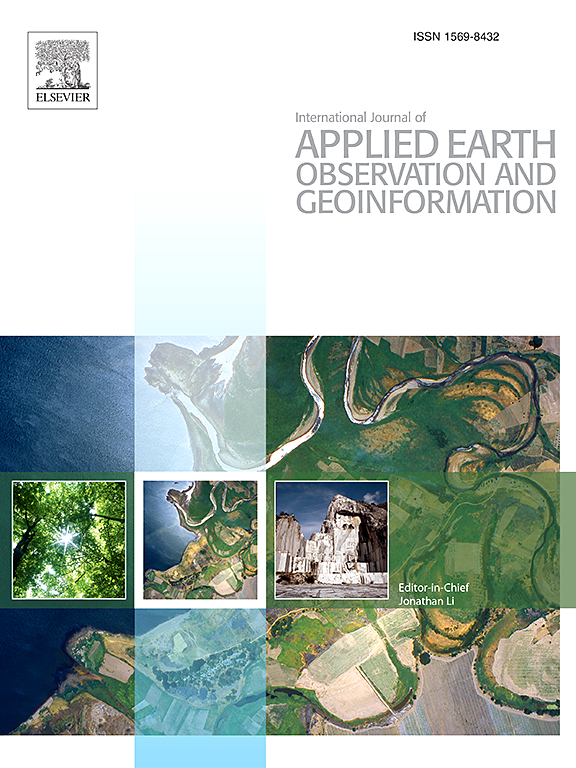SAM-CTMapper: Utilizing segment anything model and scale-aware mixed CNN-Transformer facilitates coastal wetland hyperspectral image classification
IF 7.6
Q1 REMOTE SENSING
International journal of applied earth observation and geoinformation : ITC journal
Pub Date : 2025-03-31
DOI:10.1016/j.jag.2025.104469
引用次数: 0
Abstract
Accurate and effective coastal wetland classification using hyperspectral remote sensing technology is crucial for their conservation, restoration, and sustainable development. However, the large scale variance of land covers in complex wetland scenes poses challenges for existing methods and leads to misclassifications. Additionally, existing methods encounter difficulties in practical wetland classification tasks due to the high cost of hyperspectral wetland data labeling. This paper introduces SAM-CTMapper, a coastal wetland classification framework that incorporates a scale-aware mixed CNN-Transformer (CTMapper) to precisely identify wetland cover types using hyperspectral images, and the advanced segment anything model (SAM) to save labor costs in data labeling. Specifically, a novel scale-aware mixed CNN-Transformer layer is designed in CTMapper to effectively leverage local and long-range spectral–spatial features from the whole HSI to reduce misclassification. This layer comprises a multi-head scale-aware convolution layer to capture local land-cover details, a multi-head superpixel self-attention layer for extracting long-range contextual features, and a dynamic selective module to facilitate effective aggregation of local and long-range information. Additionally, we devise a SAM-based semi-automatic labeling strategy to construct two PRISMA hyperspectral wetland (PRISMA-HW) datasets over Liaoning Shuangtai and Shanghai Chongming for evaluation purposes. Experimental results on two PRISMA-HW datasets and two publicly available hyperspectral wetland datasets demonstrate the effectiveness of CTMapper method in terms of both accuracy metrics and visual quality. For the sake of reproducibility, the PRISMA-HW datasets and the related codes of SAM-CTMapper framework will be open-sourced at: https://github.com/immortal13.
SAM-CTMapper:利用分段任意模型和尺度感知混合CNN-Transformer实现滨海湿地高光谱图像分类
利用高光谱遥感技术对滨海湿地进行准确有效的分类,对滨海湿地的保护、恢复和可持续发展具有重要意义。然而,复杂湿地场景中土地覆被的大尺度变化给现有方法带来了挑战,并导致了分类错误。此外,由于高光谱湿地数据标注成本高,现有方法在实际湿地分类任务中遇到困难。本文介绍了海岸带湿地分类框架SAM-CTMapper,该框架结合了尺度感知的混合CNN-Transformer (CTMapper),利用高光谱图像精确识别湿地覆盖类型,以及先进的分段任意模型(SAM),节省了数据标注的人工成本。具体而言,在cmapper中设计了一种新型的尺度感知混合CNN-Transformer层,以有效地利用整个HSI的局部和远程光谱空间特征来减少误分类。该层包括一个多头尺度感知卷积层,用于捕获局部土地覆盖细节;一个多头超像素自关注层,用于提取远程上下文特征;一个动态选择模块,用于有效聚合局部和远程信息。此外,我们设计了基于sam的半自动标注策略,构建了辽宁双台和上海崇明两个PRISMA高光谱湿地(PRISMA- hw)数据集进行评价。在两个PRISMA-HW数据集和两个公开的高光谱湿地数据集上的实验结果表明,CTMapper方法在精度指标和视觉质量方面都是有效的。为了再现性,PRISMA-HW数据集和sam - cmapper框架的相关代码将在https://github.com/immortal13上开源。
本文章由计算机程序翻译,如有差异,请以英文原文为准。
求助全文
约1分钟内获得全文
求助全文
来源期刊

International journal of applied earth observation and geoinformation : ITC journal
Global and Planetary Change, Management, Monitoring, Policy and Law, Earth-Surface Processes, Computers in Earth Sciences
CiteScore
12.00
自引率
0.00%
发文量
0
审稿时长
77 days
期刊介绍:
The International Journal of Applied Earth Observation and Geoinformation publishes original papers that utilize earth observation data for natural resource and environmental inventory and management. These data primarily originate from remote sensing platforms, including satellites and aircraft, supplemented by surface and subsurface measurements. Addressing natural resources such as forests, agricultural land, soils, and water, as well as environmental concerns like biodiversity, land degradation, and hazards, the journal explores conceptual and data-driven approaches. It covers geoinformation themes like capturing, databasing, visualization, interpretation, data quality, and spatial uncertainty.
 求助内容:
求助内容: 应助结果提醒方式:
应助结果提醒方式:


